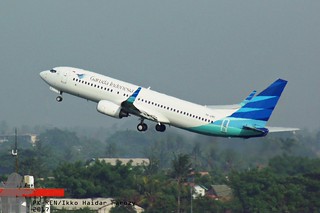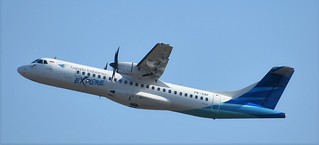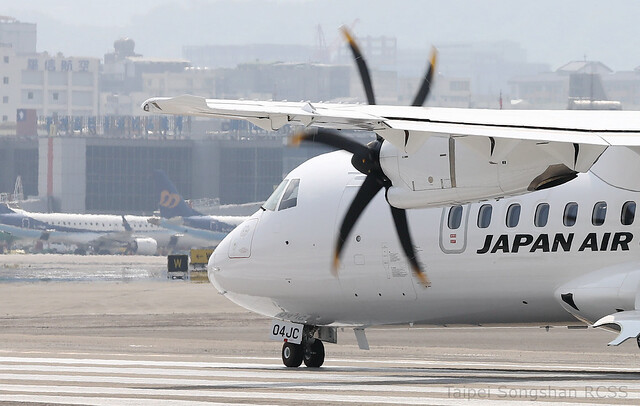Garuda AT72 at Praya on Feb 3rd 2015, runway excursion, nose gear collapse
Last Update: January 4, 2017 / 15:49:10 GMT/Zulu time
Incident Facts
Date of incident
Feb 3, 2015
Classification
Accident
Cause
Runway excursion
Airline
Garuda Indonesia
Flight number
GA-7040
Departure
Denpasar, Indonesia
Destination
Praya, Indonesia
Aircraft Registration
PK-GAG
Aircraft Type
ATR ATR-72-200
ICAO Type Designator
AT72
Airport ICAO Code
WADL
On Jan 4th 2017 Indonesia's NTSC released their final report concluding the probable causes were:
- Two transfer of control at critical altitude without clear statement might have made that pilots not aware who has the full control of the flight and jeopardize the flight when the pilot receive the control not fully aware to the condition of the flight.
- The handling of the aircraft after bounce was contrary to the wind condition, and the application of the right rudder and cross wind condition might have made the aircraft turned to the right.
The NTSC reported the captain (44, ATPL, 4,600 hours total) was also certified as training captain and had already successfully trained 8 candidates for first officer and captain. The first officer (41, CPL, 1,300 hours total, 120 hours on type) was under line training and pilot flying, a second first officer under training was occupying the observer's seat.
The aircraft was on final approach to Lombok's runway 13 cleared to land, winds were reported from 210 degrees at 12 knots, when the captain needed to assist the first officer in aligning with the runway two times at about 800 feet and about 500 feet AGL. Below 500 feet the captain took control of the aircraft and instructed the first officer to "follow control".
The aircraft touched down about 700 meters past the runway threshold, bounced two times. The captain reported the throttles were difficult to be selected into ground idle, only later the throttles reached ground idle, the aircraft however already veered right, travelled 180 meters on the runway shoulder and came to a stop 33 meters right off the paved surface of the runway. The captain called "Mayday" several times on radio, shut the engines down using the fire handles and initiated an evacuation of the aircraft. There were no injuries, the nose gear collapsed, the underside of the forward fuselage was bent and the right hand propeller was bent.
The NTSC analysed:
During the final approach, the PIC assisted the control to correct the flight track to align with the runway course for two times and when below 500 ft the PIC took over the control. After the correct flight path has been achieved, the PIC questioning the SIC handling of keeping the high descend rate when the aircraft was below the correct glide path. At this time it indicated that the SIC was controlling the aircraft, however, the CVR did not record communication between the pilot related to transfer of control form the PIC to the SIC.
The transfer of control without clear statement might have made that the SIC not aware that he has the full control of the flight. This condition might have made no one was fully responsible to control the flight. Also, as pilot under training might be very difficult to verify to the PIC.
The change over control from the SIC to the PIC occurred at below 500 feet, thereafter the CVR recorded conversation that SIC had the control of the aircraft. It can be concluded that transfer of control occurred two times on short final which was critical phase of a fligt. Transfer of control at critical phase might jeopardize a flight, especially when the pilot received the control is not fully aware to the flight condition.
The NTSB analysed landing/bounce recovery technique:
The FDR recorded that after bounce, the aircraft rolled to the left at approximately 2°, right rudder applied and left aileron up. The aircraft heading changed to the right from 130°. After the second bounce, the aircraft has firmed on the ground, the aircraft heading was 145°.
The handling of the aircraft after bounce was contrary to the wind condition, which it should be left rudder applied and right aileron up. The application of the right rudder and right cross wind condition might have made the aircraft turned to the right.
Metars:
WADL 031100Z 22003KT 8000 SCT016 27/23 Q1011 NOSIG
WADL 031030Z 23005KT 8000 FEW016 29/23 Q1011 NOSIG
WADL 031000Z 22007KT 9999 SCT016 29/23 Q1011 NOSIG
WADL 031000Z 22007KT 9999 SCT016 2/23 Q1011 NOSIG
WADL 031000Z 22007KT 9000 FEW016 29/23 Q1011 NOSIG
WADL 030930Z 23008KT 9999 SCT016 30/23 Q1010 NOSIG
WADL 030900Z 23008KT 9999 SCT016 30/23 Q1010 NOSIG
WADL 030830Z 23009KT 9999 SCT016 30/22 Q1010 NOSIG
WADL 030800Z 23009KT 9999 SCT016 30/22 Q1010 NOSIG
WADL 030730Z 26010KT 9999 SCT016 30/22 Q1010 NOSIG
WADL 030700Z 26010KT 9999 SCT016 30/22 Q1011 NOSIG
WADL 030630Z 25007KT 9999 SCT016 31/22 Q1011 NOSIG
WADL 030600Z 25007KT 9999 SCT016 31/22 Q1011 NOSIG
WADL 030500Z 24008KT 9999 SCT016 31/21 Q1012 NOSIG
Incident Facts
Date of incident
Feb 3, 2015
Classification
Accident
Cause
Runway excursion
Airline
Garuda Indonesia
Flight number
GA-7040
Departure
Denpasar, Indonesia
Destination
Praya, Indonesia
Aircraft Registration
PK-GAG
Aircraft Type
ATR ATR-72-200
ICAO Type Designator
AT72
Airport ICAO Code
WADL
This article is published under license from Avherald.com. © of text by Avherald.com.
Article source
You can read 2 more free articles without a subscription.
Subscribe now and continue reading without any limits!
Read unlimited articles and receive our daily update briefing. Gain better insights into what is happening in commercial aviation safety.
Send tip
Support AeroInside by sending a small tip amount.
Related articles
Garuda B738 at Tanjung Pinang on Apr 16th 2025, dropped nose tyre on landing
A Garuda Indonesia Boeing 737-800, registration PK-GUD performing flight GA-288 from Jakarta to Tanjung Pinang (Indonesia) with 161 people on board,…
Garuda B738 at Banjarmasin on Aug 7th 2023, tail strike on go around
A Garuda Indonesia Boeing 737-800, registration PK-GNM performing flight GA-532 from Jakarta to Banjarmasin (Indonesia) with 145 passengers and 7…
Garuda B738 at Jakarta on Mar 30th 2023, tail scrape on landing
A Garuda Boeing 737-800, registration PK-GMC performing flight GA-867 from Bangkok (Thailand) to Jakarta (Indonesia) with 76 passengers and 8 crew,…
Garuda B738 at Manado on May 31st 2023, engine problems
A Garuda Indonesia Boeing 737-800, registration PK-GMU performing flight GA-607 from Manado to Jakarta (Indonesia) with 88 people on board, was…
Garuda AT72 at Ende on Oct 19th 2015, unstabilized approach leads to bounces, runway excursion and balked landing
A Garuda Indonesia Avions de Transport Regional ATR-72-212A, registration PK-GAF performing flight GA-7017 from Kupang to Ende (Indonesia) with 16…
Newest articles
JAC AT42 at Amami on Jan 5th 2026, hydraulic failure
A JAC Japan Air Commuter Avions de Transport Regional ATR-42-600, registration JA04JC performing flight JL-3837 from Amami O Shima to Kikaiga Shima…
Emirates B772 over Saudi Arabia on Jan 4th 2026, loss of cabin pressure
An Emirates Boeing 777-200, registration A6-EWB performing flight EK-929 from Dubai (United Arab Emirates) to Cairo (Egypt), was enroute at FL360…
Subscribe today
Are you researching aviation incidents? Get access to AeroInside Insights, unlimited read access and receive the daily newsletter.
Pick your plan and subscribePartner

ELITE Simulation Solutions is a leading global provider of Flight Simulation Training Devices, IFR training software as well as flight controls and related services. Find out more.
SafetyScan Pro provides streamlined access to thousands of aviation accident reports. Tailored for your safety management efforts. Book your demo today
AeroInside Blog
Popular aircraft
Airbus A320Boeing 737-800
Boeing 737-800 MAX
Popular airlines
American AirlinesUnited
Delta
Air Canada
Lufthansa
British Airways




